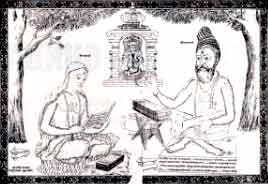Indian dream lore
According to Van de Castle, various favorable and unfavorable dream interpretations can be found in the Vedas (written between 1500 and 1000 B.C.). He said, "for example, to ride an elephant is a lucky dream, while to ride a donkey is an unlucky one. The goddess Usas is described as being able to drive away the effects of evil dreams, and several verses and hymns are available which could be sung to dispel evil dreams. The effects of bad dreams could also be counteracted by rites of purification or various types of baths."
Again, quoting further from Our Dreaming Mind, Van de Castle wrote:
"The Atharva Veda also contains some provocative speculations concerning the relation between dreams from different periods of the night and the time of their expected realization. It suggests that dreams from the first period of sleep will not come true for a year and those of the second period for eight months, while those arising from the last part of the night are already half realized. Along somewhat similar lines, it proposed that if several dreams succeed each other only the last should be interpreted. This sophisticated notion implies that the temporal unfolding of dreams reflects a hierarchical arrangement of psychological motivation. In this schema, the issues underlying our first dreams of the night have not yet been fully processed psychologically and will therefore take longer to be assimilated into waking life, while the last dreams deal with material whose mental gestation has almost been completed and which will soon be expressed in daytime activities. The last of a succession of dreams can be understood to represent our most up-to-date reaction to the material being digested by our dreaming mind.
"The Upanishads, written between 900 and 500 B.C., are primarily philosophical treatises dealing with personal salvation and deliverance from the material world. In the Brhadaranyaka Upanishad, there are two theories about dreams. One is psychological and proposes that particular objects appear in dreams as expressions of the dreamer's inner desires: "There are no (real) chariots in that state, no horses, no roads but he himself (creates) chariots, horses, and roads... He indeed is the maker." In the other theory, a metaphysical one resembling that described by the Chinese, the soul leaves the body during sleep and wanders to distant locations where it encounters the horses and roads which exist externally. If a sleeping person were to be suddenly awakened, the soul might not have adequate time to return to the body and the person would die.
"In this same Upanishad is an outline of the different states of the soul: There are two views with regard to the different states of the soul. One of them makes a distinction between the waking and sleeping states while the other regards them as having no real distinction. Another state of the soul, viz, the state of dreamless sleep or deep sleep, is the state in which the individual soul becomes identical with the Absolute.
"The concept of reincarnation seems apparent in a proposal put forth by Dvivedagana concerning the existence of another world: 'In early childhood, our dreams consist of the impressions of a former world, later on they are filled with the impressions of our senses, and in old age they contain visions of a world to come.'
"The Sushruta Samhita, a collection of medical and surgical Iore, was compiled about 600 B.C. by the surgeon Sushruta. It contains several comments about the interpretation of dreams, particularly those dealing with illness. Prophetic dreams play an important part in the great Indian epics, the Ramayana, composed around 200 B.C., and the Mahabharata, composed between that time and 200 A.D." (Van de Castle, 1994, pp. 59 - 60).
While on the theme of dreams and India, one does well to also consult the impressive work by Wendy Doniger O'Flaherty in which she analyzed the complex role of dreams and dreaming in Indian religion, philosophy, literature and art (O'Flaherty, 1984). There, she managed to bring to bear on these themes the thoughts of such disparate thinkers as Aeschylus, Plato, Freud, Jung, Gödel, Picasso and many others.
Previous section Next section List of sections List of chapters

